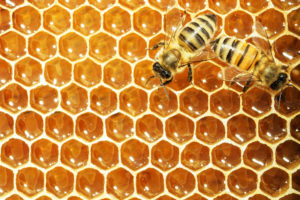At Jesus Pech-Chel’s bee colony in Mexico’s Yucatán peninsula, hundreds of bees fizz and dart about as silky honey flows from the wax combs. Jesus has been producing pure honey for 15 years. His children and nephews say they want to carry on the family tradition.
But the apparent abundance belies an uncertain future. Beekeepers like Jesus are competing with cheap, impure Chinese-made honey that is mixed with sugar syrup and bereft of the medicinal properties of the organic variety it mimics.
“We see it as a serious threat to our production,” said Jesus, who added that adulterated Chinese honey is just the latest threat to honey makers, who are already hit by climate change and pesticide use.
Today, three out of every four jars of honey sold in Mexico are counterfeited to some degree, according to Ignacio Vadillo, director of marketing at Mexico’s Ministry of Rural Development (SAGARPA). A similar phenomenon occurs in the US and Europe, where the figure is nearer 20%. Honey is the third most counterfeited food in the world, according to Larry Olmsted’s book Fake Food Real Food.
In Mexico, there are 42 thousand beekeepers who produce around 57,000 tonnes honey each year, according to SAGARPA. Beekeeping is a mainstay of a rural economy worth an estimated US$100 million annually. But Despite an uptick in 2018, production has fallen in recent years.
China, meanwhile, is the world’s top honey producer and exporter – as well as being the largest adulterator of the product. Chinese counterfeiters have developed methods over more than three decades, permeating international markets.
History of adulterated honey
The phenomenon of fake honey is not new. China has around one eighth of the world’s bee colonies but has struggled to overcome its reputation for cheap, low quality products, according to a report by news publication Sina Finance.
In the 1990s, China’s more than seven million hives began producing large quantities of cheap honey and selling to the US, undercutting local producers and leading a heavy tax.
As China’s global market share declined, honey makers began tampering with produce – adding corn and rice starch – to lower production costs. Instructional videos were widely shared online, in which the subjects add sweeteners and other syrups to the mix. Standards introduced in 2011, which focused on safety than quality, differentiated between honey and ‘honey products’, enabling many dubious products to be sold legally.
60-70%
of honey sold in China is thought to be impure
Industry insiders estimated that in 2014, some 60-70% of Chinese honey was adulterated, Sina reported. Much has now made its way to Latin America.
As adulteration methods became more sophisticated, detection became more difficult. Supposedly, a number of methods exist to ascertain the purity of honey, ranging from testing its flammability (authentic honey should catch light) to mixing adulterated honey with iodine, which will turn it blue.
Yet, only laboratory tests can truly determine whether honey is authentic, according to Ángel López Ramírez from the Faculty of Veterinary Medicine and Zootechnics at Mexico’s National Autonomous University (UNAM). Researchers can also trace the origin of honey that contains pollen. But if the pollen is filtered – as is common practice – it can’t.
Chinese honey has also been found to contain chloramphenicol, a powerful antibiotic that can lead to a life-threatening bone marrow disorder. The drug is banned for human consumption in the US.
Mexico’s honey prices
Adulterated honey can be sold at half price of the authentic product, driving down prices to lower than those needed to recoup investments, according to Vadillo.
“It affects us a lot. It’s a bad competition” he said, adding that prices have dipped from 40 pesos (US$2) per kilo to 20 pesos in three years.
By paying more, the honey will be better and the impact on nature will be more positive
David Ekmul, a local honey collector, says prices have declined by as much as three times over the same period, based on highs of 65 pesos (US$3 dollars) per kilo. He said you can usually spot fake honey because it is half the cost of authentic honey.
Anastasio Oliveros, president of the Union of Ecological Apicultural Societies of Calakmul (USAEC) said stricter government control over imported honey and more support for local producers ware needed to protect the industry.
Arturo Lonighi, an ecologist at the University of Exeter in the UK, said fairer prices can encourage better practices.
“Honey today is very cheap and the beekeeper should receive the right price for it. By paying more, the honey will be better and the impact on nature will be more positive,” he said.
Vadillo said: “If conventional honey is already a mess, the way to give it market value and make it work is to scale up organic [production] because you have to prove that you produced it fairly.”
Pech-Chel, meanwhile, pleaded with consumers to support the authentic honey trade.
“We are looking for marketing channels that don’t kill us,” he said.





